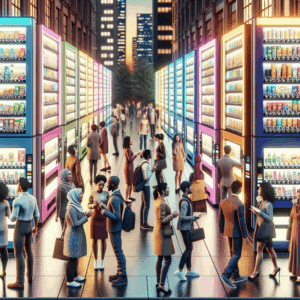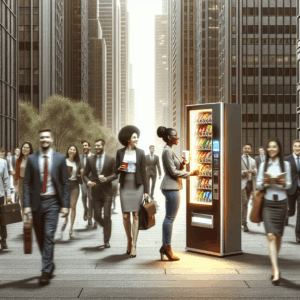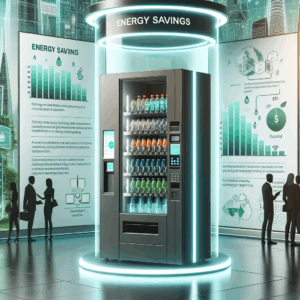Table of Contents
- Optimizing Vending Machine Locations
- Effective Maintenance Strategies
- Enhancing User Experience
- Implementing Smart Payment Systems
Optimizing Vending Machine Locations
Understanding Key Placement Benefits
From my years in the marketing world, I’ve learned that location is everything—whether you’re setting up a pop-up shop or a vending machine. The placement can significantly impact sales and customer satisfaction. Imagine placing a vending machine in a less frequented corner; it wouldn’t get much attention, right? Just like a prime-time spot for a TV commercial, that machine needs a hot spot.
When you place vending machines in high-traffic areas, you’re not only increasing visibility but also convenience for passersby. Places like office lounges, school hallways, or busy transit hubs tend to attract more users. And trust me, more visibility equals more sales. It’s like magic, but with a lot of strategy involved.
But hey, don’t just stick it in high traffic and call it a day. Think about the demographic that frequents the area. Different locations have different types of audiences wanting different snacks or drinks. Tailor your product selection to fit your audience’s tastes, and you’ll see some impressive results!
Selecting Strategic Locations
Once you’ve got an understanding of high-traffic benefits, it’s time to think strategically about where these machines should be. I always compare this to playing a game of chess; every piece— every machine—needs to be thought out carefully. Look for spots where there’s a natural pause in people’s movements like waiting areas or break rooms.
I remember one time when we installed a vending machine right by the entrance of an office building instead of in the cafeteria. It was that swift RevPAR—revenue per available room—moment. The strategy was to cater to those entering and leaving the office rather than just those who set foot in the cafeteria. Naturally, this had a direct impact on our sales.
So, don’t shy away from experimenting with different positions. Sometimes repositioning a machine just ten feet can lead to a big boost in sales. Be observant and adapt as needed for maximum returns.
Negotiating Placement Deals
Now, don’t overlook the importance of negotiating the deal for the placement of these machines. It’s all part of the game. As with any business deal, the art of negotiation lies in understanding what both parties stand to gain. Offering a profit share or payment plan could be attractive to property owners.
From my experience, I’ve found that presenting a win-win scenario gets you the best spot. If a vending machine can drive increased foot traffic or prolong a customer’s stay at the venue, that’s leverage right there. Show them the potential revenue they might miss by not having a machine, and it becomes a much easier sell.
Remember, the terms of the agreement are just as crucial. Be clear about who is responsible for the maintenance and restocking of the machines. You’re not just selling locations here; you’re building partnerships that can keep hassles at bay for good.
Effective Maintenance Strategies
Routine Check-Ups and Cleaning
If there’s one thing I’ve stressed countless times, it’s maintaining machines like they’re family cars. Constant and routine check-ups go a long way. A slick machine is a happy machine—one that fosters a delightful experience for users. The last thing you want is a stale product or a coin that gets jammed in the slot.
I often make it a habit to schedule regular visits to each location to inspect and clean the machines. These maintenance checks allow you to catch problems before they escalate into more significant issues. Regular cleaning, especially, can help prevent technical malfunctions that could frustrate users.
It’s simple physics and basic business logic: clean machines look more inviting and are less likely to face operational hitches. Let me tell y’all, it carries through the vibes of a well-oiled machine. Quite literally, keep that vending life smooth!
Tech Upgrades and Overhauls
We’re living in a golden era of technology, and maintaining vending machines shouldn’t be any different. I’ve had cases where simple tech upgrades, such as installing a digital interface or a remote monitoring system, breathe new life into old machines. These upgrades not just jazz up the appearance but enhance the functions too.
What’s beautiful is that tech updates can flank the common grievances. For example, having a machine with a real-time monitoring system allows for swift restocking and timely overall maintenance. It’s like having a vending fairy watching over, ensuring smooth operations.
And, although it might sound costly upfront, in the long run, it saves maintenance costs and heightens customer satisfaction, which is priceless. We’re all in on boosting those profit margins, aren’t we?
Feedback Loops and Responsiveness
Possibly one of my favorite hacks is turning customer feedback into gold nuggets. I once ran a campaign encouraging users to leave suggestions and be vocal about their experiences. Turns out, users love giving feedback when they know it’s being acted upon, and it has a fantastic return.
Keeping an open line for feedback helps address recurring problems and assists with implementing swift solutions. Think of it as crowdsourcing your machine maintenance process. It’s active listening but on a mechanical level.
Moreover, being responsive to feedback builds trust. It shows that you care about more than just their cash; you’re invested in improving their experience. Listening and acting swiftly can diminish a lot of those vending machine hassles over time.
Enhancing User Experience
Implementing Clear Instructions
One nugget of wisdom: make things idiot-proof. Not that people are idiots, but ensuring clear instructions on how to use the vending machine can make a world of difference. When a user approaches a machine, they need to know precisely how to get what they came for.
I usually recommend using visual aids or step-by-step graphics. It’s like when you’re assembling Ikea furniture; the pictures do wonders. Users appreciate a hassle-free and straight-to-the-point navigation. They aren’t there for puzzles, after all.
If it takes more than a couple of seconds to figure things out, the user might just throw in the towel. Make those instructions foolproof, and both you and your customers will benefit greatly.
Ensuring Product Variety
Another valuable lesson I’ve picked up: product variety is the spice of vending life. Having a diverse array not only caters to different tastes but also increases your user base. You engage more effectively when people see options beyond the usual fare.
Experimenting with product selections—like throwing a seasonal item in there every now and then—keeps things exciting. It’s also a brilliant way to test which options are a hit and which ones bomb. It could help explore what works best for different locations or times of the year.
Remember that boredom leads to no sales. Keep it fresh, keep it diverse, and customers will return repeatedly. Channel that inner marketing pizzazz to keep those options open and expansive.
User-Friendly Design
Design isn’t all about aesthetics; it’s about intuitive function too. A simple design can lead to a seamless user experience. In my experience, the easier it is for users to select, pay, and receive their product, the happier they are.
A design that considers user height, reachability, and even the placement of payment slots can make or break the experience. I always say it doesn’t have to be the snazziest looking arcade; it just has to flow well with the user.
Incorporate lights, sounds, or any form of positive feedback in your machine’s design—something that subtly says, “Great choice!” It’s all about making the user’s transaction frictionless, echoing seamless delight.
Implementing Smart Payment Systems
Adopting Cashless Payment Options
Let’s face it—coins are becoming somewhat like dinosaurs in the digital age. With the advancement of technology, I’ve switched to smart, cashless payment options wherever possible. They’re not just hip; they’re the future of vending.
In today’s era, implementing systems like contactless payment options—credit cards, mobile payments, and even digital wallets—maximize the potential of any vending machine. Not only do they cater to the more tech-savvy customer, but they also speed up the entire process.
Plus, cashless options mean reduced maintenance associated with handling cash and minimizing downtimes caused by jammed coins. The result? A smoother, more profitable experience for everyone involved.
Security Measures for Smart Systems
Integrating smart payment systems is great and all, but let’s not overlook security. With anything digital comes the need for secure operations. You’ve got to ensure safety buffers to protect user data and maintain trust.
Security isn’t just about warding off cyber attacks; its presence reassures users. Well-protected systems attract more users—you know, that peace of mind factor. Invest in reliable cybersecurity measures and conduct regular audits to stay tight-knit and ahead of issues.
When in doubt, think about your own transactions. If you feel secure using a system, then chances are your consumers will too. Peace of mind fuels repeat visits, and repeat visits keep the machine green.
Tracking Payments with Analytics
One of those “aha” moments in the vending biz came when I adopted payment tracking and analytics. These tools opened a wealth of insights that shaped future business decisions and strategies. Any pro will tell you: data is the new oil.
By monitoring sales data, you get a clear picture of peak sales times, trending products, and underperforming offerings. With such data, you can tweak your product lineup or even adjust pricing strategies to keep things lucrative.
If you’re not using analytics, you’re basically flying blind. The insights gleaned can help pre-empt hassles, allowing you to adjust course quickly while implementing data-driven changes. Knowledge is power, and it’s your secret weapon to combatting vending woes.
FAQ
What are common vending machine hassles?
Common vending machine hassles include technical malfunctions, product shortages, payment difficulties, and location visibility issues.
How can routine maintenance improve vending machine efficiency?
Routine maintenance ensures machines are clean, functioning correctly, and stocked appropriately, which minimizes breakdowns and maximizes efficiency and customer satisfaction.
Why is location important for vending machines?
Location significantly affects a vending machine’s success by increasing visibility, convenience, and accessibility to potential customers.
What role do payment systems play in enhancing user experience?
Smart payment systems improve user experience by offering fast, secure, and convenient transaction options, catering to customers who prefer cashless payments.



